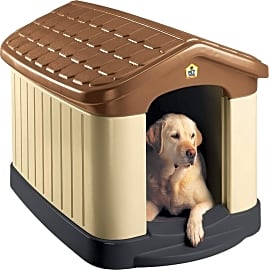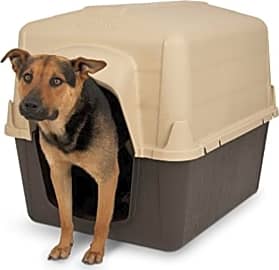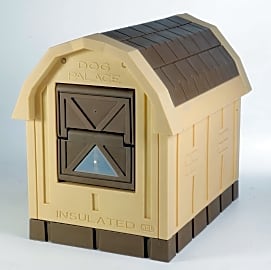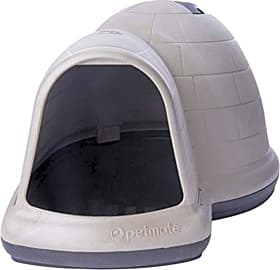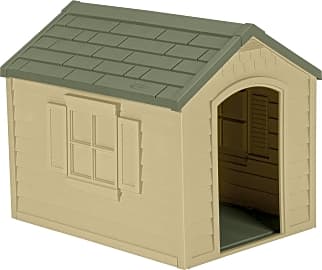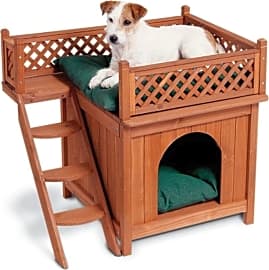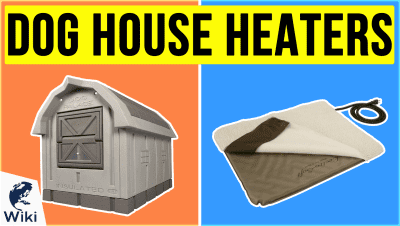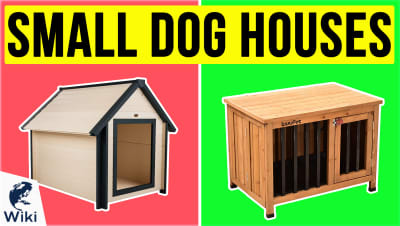The 10 Best Dog Houses

This wiki has been updated 38 times since it was first published in December of 2015. Considering dogs are devoted and loving family companions, it seems only fair to provide them with a place of their own to which they can retreat for a comfortable, dry and safe snooze. Constructed from a wide variety of materials, including woods, sturdy plastic and mesh fabrics, these houses come in a wide variety of designs and can act as a safe haven for dogs both indoors and outside When users buy our independently chosen editorial picks, we may earn commissions to help fund the Wiki.
Editor's Notes
April 09, 2020:
Although I'm the type of pet owner who prefers to have my dogs with me at all times, I'm also sensitive to the fact that, like humans, these creatures prefer some alone time. While crates are beneficial for training purposes and keeping animals under control, they also serve to keep them in one place until they're released. That's not a bad thing and there's definitely a time and place for using dog crates/kennels. But I like to think of a dog house as more of a place that allows Fido to come and go as he pleases.
We've included a variety of doggy domiciles in different shapes and constructed from natural woods and sturdy plastics that withstand harsh weather conditions. The elegant Pet Squeak Arf Frame may not be the largest option available, but its close-fitting construction is perfect for a small to medium-sized pup who prefers a cozy environment in which he can nest.
Insulation is another important consideration, especially if you plan to let your dog stay outside for long periods of time. In this situation, both the Pet Zone Tuff-N-Rugged and ASL Deluxe Dog Palace are useful options, the former of which features a double-walled design, while the latter is equipped with foam insulation in both its walls and ceiling. These models can help keep the heat out during the summer and in during the cold months. However, keep in mind that no dog house should be depended on as a complete substitute for in-home protection during extreme weather events. If you're concerned that a pet won't be warm enough in the winter (and you're unable to bring him into the house) you can always pick up an extra heater to use in his dog house.
We also added the AmazonBasics Portable, which is a great travel companion for camping trips, thanks to its lightweight design and fast setup.
If you experience humid and rainy conditions often, the antimicrobial coating and offset doorway make the Petmate Indigo a practical choice.
We also realize that dogs have a tendency to want to chew things. Therefore, if you're worried about Rex getting sick if he decides to snack on his new home, the water-based paint on the Petsfit Outdoor makes it a safe option for him and also for puppies who are still learning the rules.
Finally, the Merry Pet Home may be on the small side, but its stylish appearance will complement any outdoor decor, while creating a nice lounging area for small breeds.
Special Honors
Le Pet Luxe As a luxury pet company, Le Pet Luxe specializes in providing accessibility products and public education about the health and wellness of both dogs and cats. Playhouse builder Alan Mowrer and interior designer Michelle Pollack work with Le Pet Luxe to offers a line of extremely elegant and pricey dog houses, but the organization also donates a percentage of its sales to various pet charities, ensuring the money goes to a good cause. lepetluxe.com
Not So Far From Home
The dog house offers additional benefits besides being a separate place for your pooch to go.
Just as a person considers their home a place to go for comfort, permanence, and protection from the outdoors, it's natural for them to want to extend that same luxury to every member of the family, including the four-legged ones. Giving Fido the convenience of a well-built dog house to call his very own will ensure his safety, while giving you peace of mind that you always know where he is.
While it may be convenient to think that, like their wolf ancestors, all dogs are den animals and that crating is natural, that is not entirely true. One of the main distinctions between crating and dog houses is that while a crate keeps a dog under control or contained within an enclosed space, the dog house is designed for a pet's comfort, allowing him to come and go as he pleases with the freedom to move around outside.
Because wolves will nurse newborn pups in a maternity den, there may be an evolutionary connection between a canine's affinity for being huddled in a small space and the experience of being nurtured in a den as a vulnerable wolf pup in the wild. However, the dog house modernizes this experience for the canine and his human family so that he can have the best of both worlds, but without feeling confined or locked in a crate. This is not to say that crates are bad, but they should be used in moderation and only when necessary, whereas the dog house is a permanent place for your pet to call home.
The dog house offers additional benefits besides being a separate place for your pooch to go. It shields him from the hot sun during the summer, protects him from the bitter cold during the winter, and, assuming the structure is made from sturdy materials, will keep him from getting wet when it rains. Because dogs come in a variety of shapes and sizes, not all dog houses are created equal.
Protect And Pamper Your Pooch Outdoors
Considering the materials for a dog house is one of the most important choices one can make. The most traditional material for construction is wood. Wood is relatively inexpensive, durable, plentiful, and easy to work with. Since a dog house will likely end up outdoors and remain stationary, both cedar and redwood are popular choices, as they resist decay and naturally withstand extreme conditions.
Metal houses are practically indestructible and chew-proof, but they may not be as comfortable for extended stays.
Plastic houses, on the other hand, are lightweight and simple to keep clean, so if Fido happens to be accident-prone, then a plastic dog house is a good choice. Plastic is also easy to put together and take apart, and is naturally water-resistant. If extreme weather is common where you live, consider an insulated solution, such as one with foam-lined walls to help keep heat out during the summer and in during the winter.
One must make sure to take their dog's measurements into account before deciding on the type or size house to invest in or build from scratch. These include weight, length, width, and height. The weight can help give you a rough idea of the size of house you should get. Length measurements from nose tip to the base of the tail can help determine how long the house needs to be. Typically, a dog house should be slightly longer than the length of your dog's body. Knowing Fido's width will let you know how wide the door opening should be. Openings are often one inch wider than the overall width of the dog. Measuring the height from a dog's feet to the base of his neck will tell you how tall the entrance should be, which should be around seventy-five percent of that value.
The shape of the roof is an important consideration, as well. Most wooden dog houses come in three roof styles, including pitched, flat, and loft. Pitched roofs offer dependable protection from the rain and they resemble many human homes. Flat roofs are more modern in style and make it possible for a pup to lie on top of the house if he chooses to. Loft-style roofs are particularly common on dog houses designed for small canines, giving them a place to hang out or sunbathe on a nice day. Metal houses are practically indestructible and chew-proof, but they may not be as comfortable for extended stays.
Make sure the house you choose is equipped with a raised floor as well. While a pitched roof is great for runoff from above, one must not forget about water's ability to get inside through the door opening.
A Brief History Of The Dog House
Archaeological evidence suggests that dogs were revered as both hunting partners and messengers of the gods as far back as 4,500 B.C. in ancient Egypt. They were often kept in mud-brick kennels by the wealthy, which represent the first known and most rudimentary form of dog houses.
When hunting became a popular sport during the Middle Ages, wealthy hunters used large dog kennels to keep their prized animals safe and well-protected from harm.
They were often kept in mud-brick kennels by the wealthy, which represent the first known and most rudimentary form of dog houses.
The prevalence of the pitched-roof dog house for the elite became even more common by the 1800s when the popularity of dog breeding came into play. Fast forward to World War Two, and we'll find that the U.S. Military would come to use several breeds of dogs as messengers and mine sniffers. During this period of time, dogs were transported in vented wooden boxes that could also be used as houses on the battlefield. Since that period of time, modern dog houses have been mass-produced in factories, thanks to the wide availability of materials like plastic, plywood, and foam.
Dogs have become an iconic element of the American family, and so has the popularity, versatility, and usefulness of the dog house for ensuring a pet's comfort. Although the dog house could be perceived as a way to keep the animal separate and apart from the family in its most basic form, those who understand the power of the human-animal bond realize that the dog house represents much more than just a place to keep a pet contained. It has become synonymous with the idea of what a modern family calls home, even if the place for the dog to go isn't technically inside the house.


